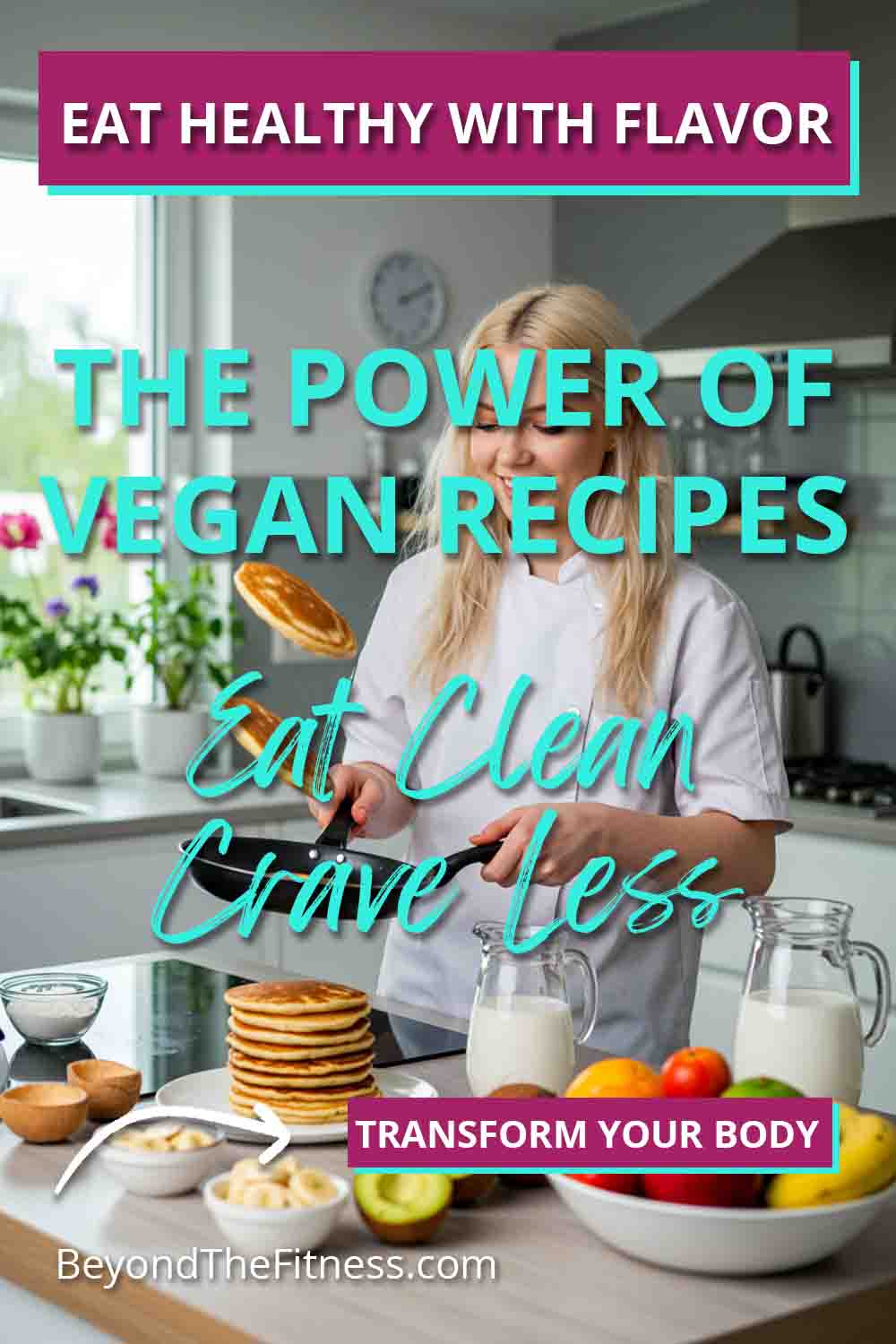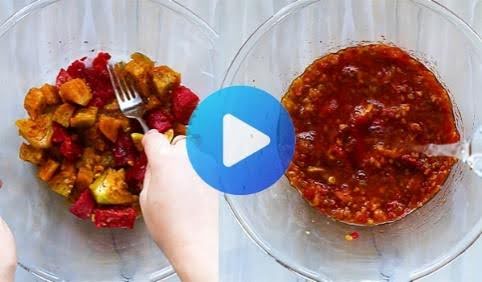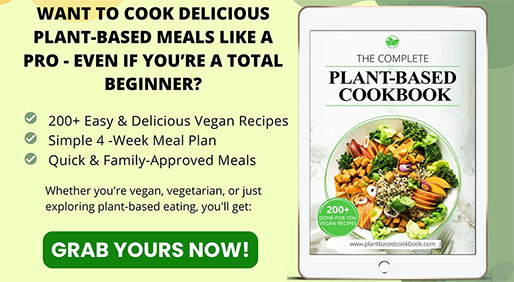Many people I talk to think that eating healthy means eating boring food. They picture plain salads or steamed vegetables with nothing on them. And when they think about vegan eating – which means not eating any animal products like meat, dairy, or eggs – they often imagine it’s even more tasteless. I’m here to tell you that this idea is completely wrong. You absolutely can eat healthy foods that taste amazing, and vegan recipes are a fantastic way to do it. Eating vegan doesn’t mean giving up flavor; it means discovering new ones.
What Does Eating Vegan Mean?
Let’s quickly talk about what vegan eating involves. It’s a way of eating that focuses entirely on plants. This includes fruits, vegetables, nuts, seeds, beans, lentils, and grains like rice and oats. Vegans choose not to eat any food that comes from an animal. This means no meat (like beef, chicken, or pork), no fish or seafood, no dairy products (like milk, cheese, or yogurt from cows or goats), no eggs, and sometimes even no honey (because it comes from bees). People choose vegan eating for different reasons – some for health, some for the environment, and some for animals. My focus here is on how it can help you eat healthy in a way that’s full of delicious tastes.
Why Choose Vegan Recipes for Your Health Goals?
Switching to more plant-based meals, even if you don’t go fully vegan, can bring some really great health benefits. As a fitness and weight loss consultant, I see how powerful these changes can be, especially for women managing their weight and overall wellness.
Insider Tip: Enjoying Healthy and Flavorful Plant-Based Dishes with The Complete Plant Based Recipe Cookbook
Helping with Weight Management
One of the big reasons people explore vegan eating is for help with managing their weight. Plant-based foods often have fewer calories packed into them compared to many animal products, especially processed meats and full-fat dairy. Think about a big bowl of colorful roasted vegetables versus a small, high-calorie cheeseburger. You can often eat a larger amount of plant foods and feel full without taking in as many calories.
A huge helper here is fiber. Fruits, vegetables, whole grains, and beans are packed with fiber. Fiber does a few wonderful things. First, it helps you feel full. When your tummy feels full, you’re less likely to overeat or snack on unhealthy things between meals. Fiber slows down digestion, which also helps keep you satisfied longer. Second, fiber is great for your digestion, keeping things moving smoothly. Many women I work with find that increasing fiber helps them feel less bloated and more comfortable.
Because vegan diets are naturally high in fiber and often lower in fat and calories, many people find it easier to lose weight or maintain a healthy weight without feeling hungry all the time. It’s not magic, but it’s a way of eating that supports your body’s natural signals of fullness.
Getting Loads of Good Nutrients
Plant foods are like nature’s multivitamins. They are bursting with vitamins, minerals, and special compounds called antioxidants that help protect your body’s cells.
- Vitamins and Minerals: Think bright oranges for Vitamin C (good for your skin and immune system), dark leafy greens like spinach for iron and calcium (important for energy and strong bones), sweet potatoes for Vitamin A (good for your eyes), and bananas for potassium (helps with muscle function). Eating a variety of colorful plants helps ensure you get a wide range of these essential nutrients.
- Antioxidants: These are like tiny bodyguards for your cells. They fight off damage from things called free radicals, which can contribute to aging and diseases. Berries, beans, nuts, and dark chocolate (yes, chocolate.) are full of antioxidants.
- Fiber: We already talked about fiber for fullness and digestion, but it does even more. It can help manage blood sugar levels and lower cholesterol.
When you fill your plate with these nutrient-rich plant foods, you’re giving your body the tools it needs to feel energetic, stay healthy, and function at its best.
Good for Your Heart
Heart health is super important for everyone, and especially as we get older. Vegan diets are naturally free of cholesterol, which is only found in animal products. They are also typically very low in saturated fat, the type of fat often linked to heart problems. Instead, they can be rich in unsaturated fats (the good kind.) found in foods like avocados, nuts, and seeds. Eating this way can help keep your cholesterol levels healthy and support a strong heart.
Happy Tummy, Happy You
Your digestive system, or your gut, is home to trillions of tiny bacteria. Having the right balance of good bacteria is really important for digestion, your immune system, and even your mood. Fiber from plant foods is the favorite food for these good gut bacteria. When you eat plenty of fiber, you help the good guys thrive, which supports overall gut health. A happy gut often means less bloating, better nutrient absorption, and feeling better overall.
Kicking the Flavorless Myth to the Curb
Okay, let’s tackle the biggest myth: that vegan food is bland. I hear this all the time. People think it’s just lettuce and maybe some plain tofu. This couldn’t be further from the truth. Think about where flavor really comes from in many dishes. Is it the plain chicken breast, or is it the herbs, spices, marinade, or sauce it’s cooked in? Flavor comes from seasonings, cooking methods, and combining different ingredients in smart ways.
Plants themselves have amazing flavors. Think about the sweetness of roasted carrots, the earthiness of mushrooms, the zing of lemon, or the heat of a chili pepper. Vegan cooking is all about learning how to unlock and combine these natural flavors. It’s an adventure in taste.
How to Make Vegan Food Taste Incredible
So, how do you actually make vegan food burst with flavor? It’s easier than you might think. It’s all about using the right tools and techniques.
The Magic of Herbs and Spices
Your spice rack is your best friend in vegan cooking. Herbs and spices can transform simple ingredients into something spectacular.
- Fresh Herbs: Things like basil, cilantro, parsley, mint, and dill add bright, fresh flavors. Add them towards the end of cooking or as a garnish. Think fresh basil on pasta or cilantro in a bean salsa.
- Dried Herbs: Oregano, thyme, rosemary, and sage are great for adding deeper, earthier flavors, especially in soups, stews, and roasted dishes.
- Spices: This is where things get really exciting.
- Warm Spices: Cinnamon, nutmeg, cloves, and ginger are great in sweet dishes like oatmeal or baked goods, but also add warmth to savory dishes like curries.
- Earthy Spices: Cumin and coriander are staples in many cuisines like Indian and Mexican. They add a savory depth.
- Spicy Spices: Chili powder, cayenne pepper, red pepper flakes add heat. You can control how much you use.
- Smoky Spices: Smoked paprika is amazing. It gives a smoky, almost bacon-like flavor without any meat. Paprika (regular) adds color and mild flavor.
- Savory Spices: Garlic powder and onion powder are easy ways to add base flavors to almost anything. Turmeric adds beautiful yellow color and an earthy taste, often used in curries.
Don’t be afraid to experiment. Start with small amounts and taste as you go. Combine different spices to create your own unique blends.
Sauces and Dressings: The Flavor Boosters
Sauces and dressings can take a simple bowl of grains and veggies from okay to “Wow.” And you don’t need dairy or eggs to make creamy, delicious sauces.
- Creamy Bases: Raw cashews soaked in water and blended make an incredibly creamy base for sauces, mimicking heavy cream. Tahini (sesame seed paste) is great for dressings and sauces, especially in Mediterranean flavors. Avocados can be blended into creamy dressings too. Silken tofu also blends up smoothly.
- Vinaigrettes: A simple mix of oil (like olive oil), acid (like lemon juice or vinegar), and seasonings makes a light, zesty dressing for salads or roasted vegetables.
- Marinades: Marinating tofu, tempeh, or even vegetables before cooking infuses them with flavor. Think soy sauce, ginger, garlic, and sesame oil for an Asian-inspired marinade, or lemon juice, oregano, and garlic for a Greek style.
- Pestos: You can make pesto without cheese. Use nutritional yeast for a cheesy flavor, or just focus on the basil, pine nuts (or walnuts), garlic, and olive oil.
- Nutritional Yeast: This is a deactivated yeast that has a cheesy, nutty flavor. It’s amazing sprinkled on popcorn, pasta, or blended into sauces to give a cheesy taste without dairy.
Cooking Methods Matter
How you cook your vegetables makes a huge difference in their flavor and texture.
- Roasting: Roasting vegetables like broccoli, Brussels sprouts, sweet potatoes, carrots, and onions in a hot oven brings out their natural sweetness and makes them tender with slightly crispy edges. Just toss them with a little oil and seasoning.
- Grilling: Grilling gives vegetables and plant-based proteins like tofu or veggie burgers a smoky char that’s delicious.
- Sautéing: Quickly cooking vegetables in a pan with a little oil over medium-high heat keeps them crisp-tender and flavorful. Adding garlic, onions, or spices early in the process builds flavor.
- Caramelizing: Slowly cooking onions or other vegetables over low heat allows their natural sugars to caramelize, creating a deep, sweet, rich flavor. Perfect for adding depth to soups or sauces.
- Stir-frying: A quick, high-heat method perfect for creating flavorful Asian-inspired dishes with crisp vegetables and savory sauces.
Finding That Savory “Umami” Taste
Umami is often described as the fifth taste – that savory, meaty, deeply satisfying flavor. Many people think it only comes from meat, but plants have it too.
- Mushrooms: Especially varieties like shiitake or cremini, are packed with umami. Roasting or sautéing them deepens their flavor.
- Tomatoes: Especially sun-dried tomatoes or tomato paste, offer a concentrated umami kick.
- Nutritional Yeast: We mentioned it for cheesiness, but it also provides a savory, umami flavor.
- Soy Sauce or Tamari: These fermented soy products are classic umami sources. Tamari is usually gluten-free.
- Seaweed: Nori (sushi sheets) or other sea vegetables add a savory, ocean-like flavor.
- Miso Paste: Fermented soybean paste used in Japanese cooking adds salty, savory depth to soups and sauces.
Layering these umami-rich ingredients can make vegan dishes incredibly satisfying.
Don’t Forget Texture
A great meal isn’t just about taste; it’s also about texture. Vegan cooking offers amazing textural variety.
- Crunch: Add toasted nuts (almonds, walnuts), seeds (pumpkin, sunflower), crispy roasted chickpeas, or raw veggies like bell peppers or celery.
- Creaminess: Avocado, cashew cream, hummus, tahini dressing, or creamy polenta provide smoothness.
- Chewiness: Whole grains like farro or barley, chewy baked tofu or tempeh, or hearty beans offer a satisfying chew.
- Softness: Roasted sweet potatoes, mashed potatoes, soft lentils, or silken tofu provide tenderness.
Combining different textures in one dish makes it much more interesting and enjoyable to eat. Think of a salad with crisp lettuce, creamy avocado, crunchy nuts, and chewy beans.
Easy Vegan Swaps for Everyday Meals
Making meals more plant-based doesn’t require completely new recipes. You can often swap ingredients in dishes you already love.
- Ground Meat: Use lentils (brown or green), crumbled tofu or tempeh, finely chopped mushrooms, or store-bought vegan ground crumbles in chili, pasta sauce, tacos, or shepherd’s pie.
- Milk: Use unsweetened almond, soy, oat, or cashew milk in cereal, smoothies, baking, or creamy sauces. Choose fortified versions for added calcium and Vitamin D.
- Cheese: Sprinkle nutritional yeast for a cheesy flavor. Use store-bought vegan cheese shreds or slices (they’ve improved a lot.). Blend cashews for creamy cheese sauces.
- Butter: Use olive oil, coconut oil, avocado oil, or vegan butter spreads for cooking or baking. Use mashed avocado or nut butter as a spread on toast.
- Eggs: In baking, use flax eggs (1 tablespoon ground flaxseed mixed with 3 tablespoons water, let sit for 5 minutes), mashed banana, applesauce, or commercial egg replacers. For scrambled eggs, try crumbled tofu seasoned with turmeric (for color) and black salt (kala namak, for an eggy smell).
- Meat/Poultry: Use tofu, tempeh, seitan (if not gluten-sensitive), large portobello mushrooms, eggplant slices, or hearty beans/lentils as the centerpiece of a meal.
Building a Day of Delicious Vegan Meals
Let’s see how easy it is to put together flavorful vegan meals throughout the day.
Breakfast Ideas
- Oatmeal: Cook oats with plant milk. Top with berries, sliced banana, chopped nuts or seeds, and a drizzle of maple syrup or a sprinkle of cinnamon.
- Tofu Scramble: Crumble firm tofu and sauté it with onions, peppers, spinach, and spices like turmeric, cumin, garlic powder, and a pinch of black salt. Serve with whole-wheat toast and avocado.
- Smoothies: Blend plant milk, spinach or kale (you won’t taste it.), frozen fruit (like berries or mango), a banana for creaminess, and maybe some chia seeds or protein powder.
- Whole-Wheat Pancakes/Waffles: Use plant milk and a flax egg in your favorite recipe. Top with fruit and maple syrup.
- Avocado Toast: Mash avocado on whole-wheat toast. Sprinkle with red pepper flakes, everything bagel seasoning, or nutritional yeast.
Lunch Ideas
- Hearty Salad: Start with mixed greens. Add chickpeas or lentils, quinoa, roasted vegetables, chopped nuts or seeds, and a flavorful vinaigrette or tahini dressing.
- Veggie Wrap: Spread hummus on a whole-wheat tortilla. Fill with lettuce, shredded carrots, cucumber, bell peppers, avocado, and maybe some baked tofu strips.
- Lentil Soup: A classic, comforting, and filling soup packed with fiber and protein. Add vegetables like carrots, celery, and onions, and season well with herbs.
- Leftovers: Dinner leftovers often make a great, easy lunch.
- Buddha Bowl: A base of grains (quinoa, brown rice), topped with various roasted or raw veggies, a protein source (beans, tofu), and a yummy sauce.
Dinner Ideas
- Veggie Curry: Sauté onions, garlic, and ginger. Add spices like curry powder, turmeric, and cumin. Stir in coconut milk, vegetables (like potatoes, cauliflower, peas, spinach), and chickpeas or lentils. Serve with rice.
- Pasta with Veggie Sauce: Make a rich tomato sauce loaded with vegetables like zucchini, mushrooms, onions, and bell peppers. Add lentils for extra protein. Serve over whole-wheat pasta. Try a creamy cashew-based tomato sauce.
- Stir-Fry: Stir-fry tofu or tempeh with broccoli, carrots, snow peas, and bell peppers in a savory sauce made with soy sauce, ginger, garlic, and sesame oil. Serve over brown rice.
- Black Bean Burgers: Make homemade burgers from black beans, oats or breadcrumbs, onions, and spices. Serve on a whole-wheat bun with your favorite toppings like avocado, lettuce, tomato, and onion.
- Vegan Chili: A hearty chili made with kidney beans, black beans, pinto beans, tomatoes, onions, peppers, and chili spices. Top with avocado or vegan sour cream.
Snack Ideas
- Fruit: Apples, bananas, oranges, berries, grapes – simple and healthy.
- Nuts and Seeds: A small handful of almonds, walnuts, pumpkin seeds, or sunflower seeds.
- Vegetables and Hummus: Carrot sticks, cucumber slices, bell pepper strips dipped in hummus.
- Apple Slices with Peanut Butter: A classic, satisfying snack.
- Roasted Chickpeas: Toss chickpeas with oil and spices (like paprika and garlic powder) and roast until crispy.
- Rice Cakes with Avocado or Nut Butter: A light, crunchy snack.
Tips for Getting Started with More Vegan Meals
Feeling inspired but not sure where to start? Here are my tips:
- Start Small: You don’t have to go vegan overnight. Try “Meatless Monday” where you eat vegan just one day a week. Or start by making one meal a day vegan, like breakfast.
- Focus on Adding, Not Just Taking Away: Instead of thinking about what you can’t eat, focus on all the delicious plant foods you can add to your meals. Add beans to your soup, spinach to your smoothie, or extra veggies to your pasta sauce.
- Veganize Your Favorites: Think about meals you already love and figure out how to make vegan versions using the swaps we talked about earlier. Love tacos? Try lentil tacos. Love pasta? Try a veggie-loaded sauce.
- Explore World Cuisines: Many cultures have amazing naturally vegan or easily adaptable dishes. Indian (lentil dals, chickpea curries), Thai (coconut curries, tofu stir-fries), Mexican (bean burritos without cheese/sour cream, veggie fajitas), Ethiopian (lentil stews, veggie platters), and Mediterranean (hummus, falafel, salads) cuisines are great places to find inspiration.
- Stock Your Pantry: Keep staples on hand like canned beans, lentils, diced tomatoes, pasta, rice, oats, nuts, seeds, spices, onions, garlic, and potatoes. This makes throwing together a vegan meal much easier.
- Don’t Aim for Perfection: It’s okay if you slip up or decide not to be 100% vegan. Any step towards eating more plants is a positive step for your health. Be kind to yourself and enjoy the process of discovering new foods.
- Find Simple Recipes: Look for recipes with fewer ingredients and simple instructions to start. There are tons of great vegan blogs, cookbooks, and websites out there.
What About Protein and Other Nutrients?
This is a common question. “Where do you get your protein?” The good news is, protein is found in many plant foods.
- Good Plant Protein Sources: Lentils, chickpeas, black beans, kidney beans, tofu, tempeh, edamame (soybeans), quinoa, nuts (almonds, peanuts, walnuts), seeds (chia, hemp, flax, pumpkin), peanut butter, and even whole grains and some vegetables contain protein. Eating a variety of these foods throughout the day makes it easy to get enough protein.
Two nutrients to be a little more mindful of on a vegan diet are Vitamin B12 and Iron.
- Vitamin B12: This vitamin is mostly found in animal products. It’s important for nerve function and making red blood cells. Vegans should look for foods fortified with B12 (like some plant milks, cereals, and nutritional yeast) or consider taking a B12 supplement. It’s always a good idea to talk to your doctor about this.
- Iron: Plant-based iron (non-heme iron) isn’t absorbed as easily as iron from meat (heme iron). However, you can boost absorption by eating iron-rich plant foods (like lentils, spinach, tofu, fortified cereals) along with foods high in Vitamin C (like oranges, bell peppers, strawberries, broccoli). For women, who often have higher iron needs, paying attention to iron sources is particularly important.
Fueling Your Workouts with Plants
Can you be active and strong on a vegan diet? Absolutely. Many successful athletes follow vegan diets. Plant foods provide excellent fuel for exercise.
- Carbohydrates for Energy: Whole grains (oats, brown rice, quinoa), fruits, and starchy vegetables (sweet potatoes, squash) provide carbohydrates, which are your body’s main source of energy for workouts.
- Protein for Muscle Repair: As we discussed, beans, lentils, tofu, tempeh, nuts, and seeds provide protein needed to repair and build muscle after exercise. A post-workout smoothie with plant milk, fruit, and plant-based protein powder or peanut butter can be a great recovery option.
- Hydration: Don’t forget water. And many fruits and vegetables also have high water content, contributing to hydration.
- Nutrient Power: The vitamins, minerals, and antioxidants in plants help support overall health, reduce inflammation, and aid recovery.
Special Thoughts for Women’s Health
As I mentioned, paying attention to iron and calcium is often important for women.
- Iron: Include plenty of iron-rich foods like lentils, chickpeas, spinach, tofu, and pumpkin seeds. Pair them with Vitamin C sources.
- Calcium: Essential for bone health, especially as women age. Good vegan sources include fortified plant milks and juices, calcium-set tofu, leafy greens (kale, collard greens, bok choy), broccoli, almonds, and tahini. Ensuring enough Vitamin D (from fortified foods or sunshine/supplements) is also key for calcium absorption.
- Fiber: The high fiber content can be beneficial for hormonal balance and managing conditions like PCOS, though individual responses vary.
Focusing on a whole-foods, plant-based approach provides the nutrients needed to support women’s health through various life stages.
You Might Be Interested In: Exploring Delicious Vegan Recipes With This Cookbook
Delicious Vegan Meal Ideas to Spark Your Imagination
Here are a few ideas focusing on flavor combinations:
- Creamy Tomato Pasta with Cashew Sauce: Imagine pasta coated in a rich, creamy sauce made from blended cashews, sun-dried tomatoes, garlic, basil, and nutritional yeast. It tastes decadent but is full of healthy fats and plant goodness.
- Spicy Black Bean Burgers on Whole Wheat Buns: Hearty, flavorful burgers made with black beans, corn, oats, chili powder, cumin, and smoked paprika. Served on a toasted bun with creamy avocado, crisp lettuce, juicy tomato, and maybe a tangy salsa. Way better than store-bought.
- Roasted Sweet Potato and Chickpea Bowl with Lemon-Tahini Dressing: Cubes of sweet potato roasted until sweet and tender, combined with crispy roasted chickpeas, fluffy quinoa, and maybe some kale. Drizzled with a zesty, creamy dressing made from tahini, lemon juice, garlic, and water. A perfect balance of sweet, savory, earthy, and bright flavors with great textures.
- Lentil Shepherd’s Pie with Mashed Cauliflower Topping: A comforting base of brown lentils and vegetables cooked in a savory gravy, topped with creamy, fluffy mashed cauliflower instead of potatoes. A lighter, yet deeply satisfying, take on a classic.
- Thai Green Curry with Tofu and Vegetables: Cubes of tofu simmered in a fragrant green curry sauce made with coconut milk, green curry paste, lime leaves, basil, and loaded with colorful vegetables like broccoli, bell peppers, and bamboo shoots. Served over jasmine rice. Spicy, creamy, and full of complex flavors.
See? Vegan food is anything but boring. It’s about creativity, flavor, and nourishing your body with delicious, wholesome foods. Give it a try, explore new tastes, and you might just surprise yourself with how much you enjoy eating healthy without sacrificing flavor.
Related YouTube Video
Final Thoughts
Eating healthy doesn’t have to feel like a punishment or a chore. By exploring the world of vegan recipes, you open up a universe of flavors using spices, herbs, sauces, and smart cooking techniques. You can absolutely nourish your body, manage your weight, and feel energetic while enjoying food that tastes truly wonderful. It’s about discovering the power and deliciousness of plants.







